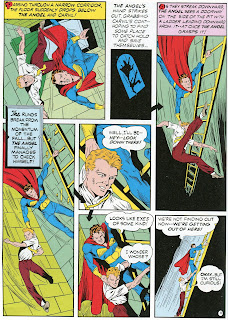Because whether Barks had realized it or not, he had created someone who would evolve into the greatest comic book character of all time. It would take awhile for Scrooge to fully develop his unique personality, but he'd get there eventually.
If nothing else, Scrooge proved to be an effective plot device to thrust Donald and the nephews into adventures. Scrooge's second appearance was in Four Color #189 (June 1948) in "The Old Castle's Secret," in which the rich water fowl does indeed get the boys into trouble.
To be fair, he does go along with them and share in the trouble. It seems Scrooge is on the verge of bankruptcy. (Barks hadn't come up with the concept of the Money Bin yet.) But there's hope. There's a treasure hidden in his ancestral castle in Scotland. Scrooge plans on bringing the boys to help him out as he scans the walls with an X-ray machine to find the treasure.
Of course, they'll all have to take care to avoid or fend off the ghost that haunts the castle.
 This leads to the sort of delightful adventure that is representative of Carl Barks' storytelling genius. While Donald and Scrooge take turns panicking over apparently supernatural shenanigans, the three nephews keep their heads. When the Ducks are trapped on a balcony, it's the nephews who come up with a clever escape plan. When the boys are trapped outside the castle, they deduce the location of a secret tunnel that gets them back in. When they encounter the ghost--who is alternately either completely invisible or shows the shadow a skeleton against the wall, they... well, mostly they run. But eventually they gain the upper hand, catch the "ghost" and find the treasure.
This leads to the sort of delightful adventure that is representative of Carl Barks' storytelling genius. While Donald and Scrooge take turns panicking over apparently supernatural shenanigans, the three nephews keep their heads. When the Ducks are trapped on a balcony, it's the nephews who come up with a clever escape plan. When the boys are trapped outside the castle, they deduce the location of a secret tunnel that gets them back in. When they encounter the ghost--who is alternately either completely invisible or shows the shadow a skeleton against the wall, they... well, mostly they run. But eventually they gain the upper hand, catch the "ghost" and find the treasure.Barks does here what he did in other Donald and/or Uncle Scrooge tales: He combines visual gags and slapstick humor with a strong "realistic" plot. This time around, he combines elements of a detective story with those of a horror story. This is combined with his clean and appealing visual artistry to turn "The Old Castle's Secret" into something very unique.
 Scrooge McDuck hasn't yet developed the personality traits that would soon turn him into a comic book character whose pure awesomeness makes Batman cry and Wolverine beg for mercy. This time around, he allows the nephews to carry the bulk of the action. But it won't be long before he becomes awesome in his own right and--in the meantime--we'll still have enormous fun hanging out with him.
Scrooge McDuck hasn't yet developed the personality traits that would soon turn him into a comic book character whose pure awesomeness makes Batman cry and Wolverine beg for mercy. This time around, he allows the nephews to carry the bulk of the action. But it won't be long before he becomes awesome in his own right and--in the meantime--we'll still have enormous fun hanging out with him.
















































